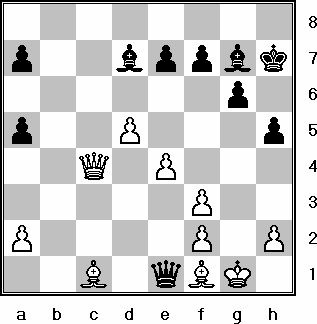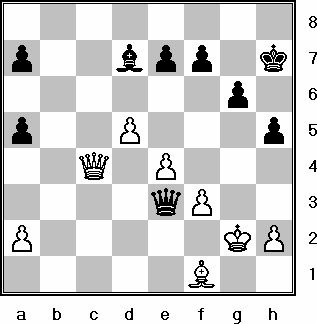|
Lesson
#2
How's a Chess Master Like a Duck?
How does a chess master think? Yes, he calculates moves, but
this alone does not work that well. We humans can calculate only one or two
moves per second while computers can see millions of moves per second. There
most be another kind of thinking the chess master is better at than computers.
The key to chess mastery starts with good questions (Q) you (U) ask and then
answer (A). Only then does the master calculate (C) a series of moves and
concludes (C) who stands better. So now you know the chess master goes:
Q U A C C !
The more you QUACC the better you play. Really good players QUACC a lot.
|
|
 |
Black to move
|
Questioning
The chess master searches for the right move. It is often not easy to find.
So, like a detective, he looks for clues. How does he find these clues? He asks
good questions and tries to answer them. Questions like "how can I win this
game?" are too general. To be useful you need to be more specific. In the
position below black is looking for a way to make progress. Can you ask a few
good questions for black?
Good questions to ask are: 1) What weaknesses does white have? 2) How can I
take advantage of the pinned bishop on f1? 3) How can I get all my pieces in the
game? 4) How can I take advantage of tie-up of the white queen (she has to guard
both bishops)? By asking good questions you open your mind to new ideas.
Answering
Did you find the answers to the questions? 1) White’s weaknesses are on f1,
f2 and f3. 2) Black can attack the pinned bishop with Bh3 or Bb5 but the latter
move does not work right now. 3) Black’s dark-squared bishop could be used to
attack the weak f2 pawn. 4) Oh! If the white queen moves off the f1-a6 diagonal
I can play Bb5!
These answers lead black to find the beautiful move 1. ... Bd4! It combines
all of the key ideas. But QUA doesn’t sound like a duck yet.
Calculating
Before playing 1. ... Bd4 we need to see that 2. Qxd4 loses to 2. ...
Bb5 3. Kg2 Qxf1+ 4. Kg3 Qxc1. From here we can Conclude that black is winning
with the extra piece and a strong mating attack. QUACC!
Don’t stop QUACCing. Before playing 1. ... Bd4 we need to calculate another
line. White could play 2. Be3 instead. This is the best try to address the
weaknesses we discovered. So we calculate that we can win a pawn with 2. ...
Bxe3 3. fxe3 Qxe3+ 4. Kg2.
Concluding
From here we can conclude that our game is better and that we have good
winning chances due to white’s exposed king and we play 1. ... Bd4. A good
QUACC indeed!
|
|

|
Black to move
|
Like a duck, we must QUACC again! Good questions in the position after 4. Kg2
are: Can I force the white king to h3 so I can take the f3 pawn with my queen?
Can I get the white king into a mating net with a series of checks? See if you
can QUACC it out for yourself (answer below).
QUACC answer: 4. ... Bh3+! 5. Kg3 (5. Kxh3 Qxf3+ 6. Kh4 Qg4#) h4+! 6. Kxh4
(6. Kxh3 Qxf3+ 7. Kxh4 as the same as below) Qf4+ 7. Kxh3 Qxf3+ (achieving our
goal) 8. Kh4 f6! 8. Qc1 g5+ winning the queen.
Home Page ·
More Lessons
(c) 2001 Ross Stoutenborough
|